I thought that I did this once before, but I seem not to have a record of it, so here goes:
The Queen's Beasts are ten heraldic statues depicting the genealogy of Queen Elizabeth II. They were commissioned by the British Ministry of Works from sculptor James Woodford (who was paid the sum of £2,750 for the work) to stand in front of the temporary annex to Westminster Abbey for the Queen's coronation in 1953. The beasts are some six-foot (1.83 m) high, cast in plaster, and could not therefore be left in the open air.
The beasts are:
The Lion of England,
The Griffin of Edward III,
The Falcon of the Plantagenets,
The Black Bull of Clarence,
The Yale of Beaufort,
The White Lion of Mortimer,
The White Greyhound of Richmond,
The Red Dragon of Wales,
The unicorn of Scotland,
and
The White Horse of Hanover.
After the coronation, they were removed to the Great Hall in Hampton Court Palace and, in 1957, were relocated to St George's Hall at Windsor Castle. The beasts were taken into storage in April 1958 whilst their future was considered. It was eventually decided to offer them to the Commonwealth governments and Canada, being the senior nation, was offered them first. In June 1959, the Canadian government accepted the beasts and they were shipped there in July. Originally, the only part of the statues to be coloured was their heraldic shields; but, for the celebrations of the Canadian federation in 1967, the statues were painted in their full heraldic colours. They are now in the care of the Canadian Museum of Civilization in Gatineau.
In 1958, Sir Henry Ross, Chairman of the Distillers Company in Edinburgh, paid for Portland stone replicas of these statues, which are on display outside the Palm House at Kew Gardens. The beasts also served as models for topiary at Hall Place, Bexley. The original sculptures have been commemorated in the following forms: bone china figurines, cups and saucers, glass tray sets, plaster models, reclaimed material reproductions, porcelain candlesticks, British postage stamps issued in 1998, silver tea spoons, and tea towels.
James Woodford (1893-1976), was an English sculptor, born in Nottingham who trained at the Royal College of Art. He was awarded the Prix de Rome for Sculpture in 1922.
The Queen's Beasts
- Chas Charles-Dunne
- Posts: 624
- Joined: 10 Jul 2012, 15:48
- Location: England - TL 80102 93862
- Contact:
The Queen's Beasts
Regards
Chas
IAAH Fellow

Chas
IAAH Fellow

- Chas Charles-Dunne
- Posts: 624
- Joined: 10 Jul 2012, 15:48
- Location: England - TL 80102 93862
- Contact:
Re: The Queen's Beasts
1 - The Lion of England
“The crowned golden lion of England has been one of the supporters of the Royal Arms since the accession of James I in 1603. The shield shows the Royal Arms as they have been borne since Queen Victoria came to the throne in 1837. In the first and last quarters are the lions of England; the lion and tressure (a double frame) of Scotland appear in the second and the harp of Ireland in the third. Richard Lion-heart, son of Henry II, probably first chose 3 golden lions set one above each on a red field as the Royal Arms of England. Since then, these lions have appeared on the coat of arms of every sovereign of this country.”
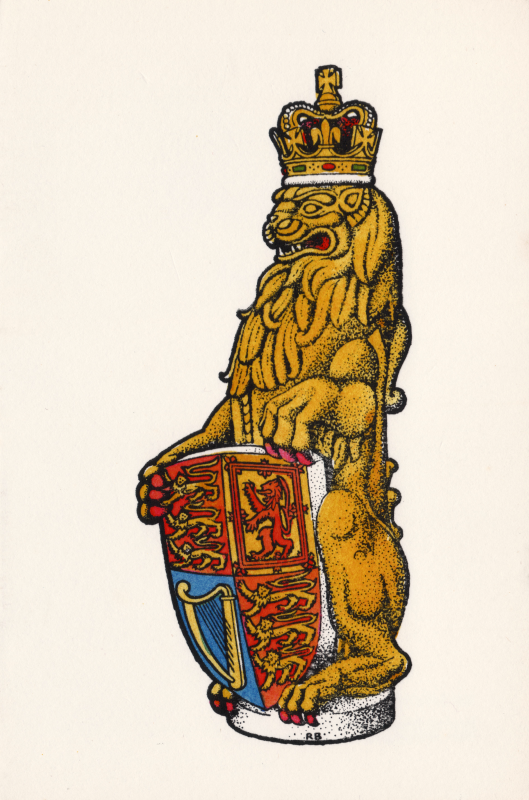
“The crowned golden lion of England has been one of the supporters of the Royal Arms since the accession of James I in 1603. The shield shows the Royal Arms as they have been borne since Queen Victoria came to the throne in 1837. In the first and last quarters are the lions of England; the lion and tressure (a double frame) of Scotland appear in the second and the harp of Ireland in the third. Richard Lion-heart, son of Henry II, probably first chose 3 golden lions set one above each on a red field as the Royal Arms of England. Since then, these lions have appeared on the coat of arms of every sovereign of this country.”

Regards
Chas
IAAH Fellow

Chas
IAAH Fellow

- Chas Charles-Dunne
- Posts: 624
- Joined: 10 Jul 2012, 15:48
- Location: England - TL 80102 93862
- Contact:
Re: The Queen's Beasts
2 The Griffin of Edward III
“The griffin is an ancient mythical beast. It was considered a beneficent creature, signifying courage and strength, combined with guardianship, vigilance, swiftness and keen vision. It was closely associated with Edward III who engraved it on his private seal. The shield shows the Round Tower of Windsor Castle with the Royal Standard flying from the turret (the badge of the present House of Windsor), enclosed by two branches of oak surmounted by the royal crown.”
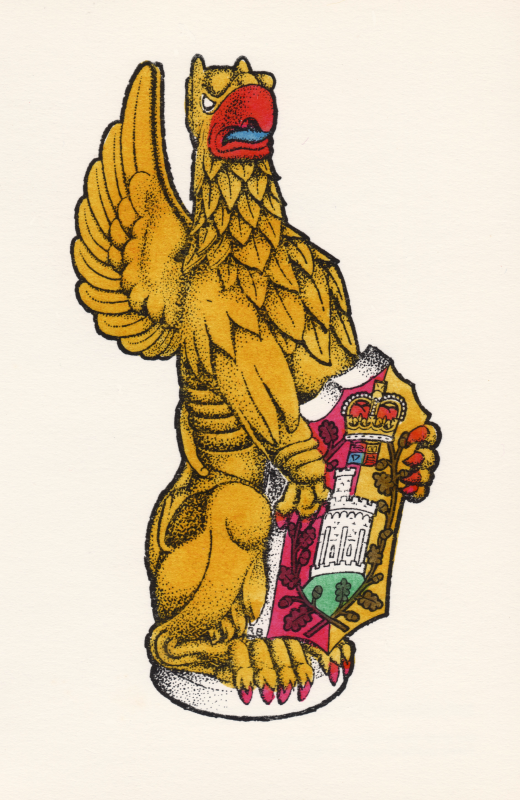
“The griffin is an ancient mythical beast. It was considered a beneficent creature, signifying courage and strength, combined with guardianship, vigilance, swiftness and keen vision. It was closely associated with Edward III who engraved it on his private seal. The shield shows the Round Tower of Windsor Castle with the Royal Standard flying from the turret (the badge of the present House of Windsor), enclosed by two branches of oak surmounted by the royal crown.”

Regards
Chas
IAAH Fellow

Chas
IAAH Fellow

- Chas Charles-Dunne
- Posts: 624
- Joined: 10 Jul 2012, 15:48
- Location: England - TL 80102 93862
- Contact:
Re: The Queen's Beasts
3 The Falcon of the Plantagenets
“The falcon was first used by Edward III as his badge. It descended to Edward IV, who took it as his personal badge, the falcon being seated within an open fetterlock or padlock. The slightly open fetterlock (which can be seen on the shield) is supposed to refer to the struggle Edward IV had to ascend the throne - he forced the lock and won the throne.”

“The falcon was first used by Edward III as his badge. It descended to Edward IV, who took it as his personal badge, the falcon being seated within an open fetterlock or padlock. The slightly open fetterlock (which can be seen on the shield) is supposed to refer to the struggle Edward IV had to ascend the throne - he forced the lock and won the throne.”

Regards
Chas
IAAH Fellow

Chas
IAAH Fellow

- Chas Charles-Dunne
- Posts: 624
- Joined: 10 Jul 2012, 15:48
- Location: England - TL 80102 93862
- Contact:
Re: The Queen's Beasts
4 The Black Bull of Clarence
“This beast descended to the Queen through Edward IV. The shield shows the Royal Arms as they were borne not only by Edward IV and his brother Richard III, but by all the Sovereigns of the Houses of Lancaster and Tudor.”
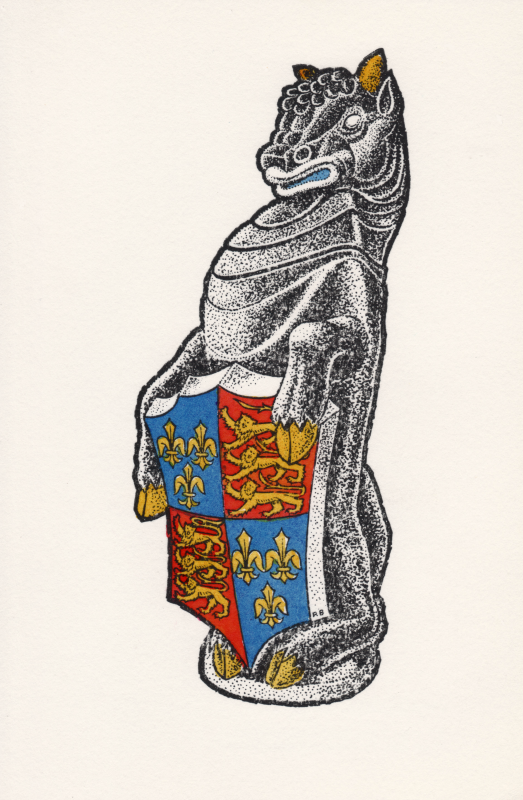
“This beast descended to the Queen through Edward IV. The shield shows the Royal Arms as they were borne not only by Edward IV and his brother Richard III, but by all the Sovereigns of the Houses of Lancaster and Tudor.”

Regards
Chas
IAAH Fellow

Chas
IAAH Fellow

- Chas Charles-Dunne
- Posts: 624
- Joined: 10 Jul 2012, 15:48
- Location: England - TL 80102 93862
- Contact:
Re: The Queen's Beasts
5 The White Lion of Mortimer
“The White Lion of Mortimer descends to the Queen through Edward IV. The shield shows a white rose encircled by a golden sun, known heraldically as a ‘white rose en soleil’ which is really a combination of two distinct badges. Both of these appear on the Great Seals of Edward IV and Richard III, and were used by George VI when Duke of York. Unlike the Lion of England, this beast is uncrowned.”
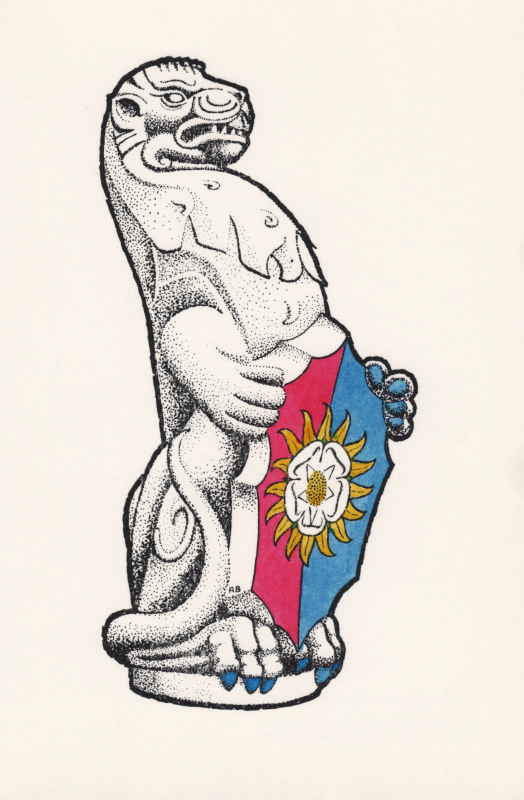
“The White Lion of Mortimer descends to the Queen through Edward IV. The shield shows a white rose encircled by a golden sun, known heraldically as a ‘white rose en soleil’ which is really a combination of two distinct badges. Both of these appear on the Great Seals of Edward IV and Richard III, and were used by George VI when Duke of York. Unlike the Lion of England, this beast is uncrowned.”

Regards
Chas
IAAH Fellow

Chas
IAAH Fellow

- Chas Charles-Dunne
- Posts: 624
- Joined: 10 Jul 2012, 15:48
- Location: England - TL 80102 93862
- Contact:
Re: The Queen's Beasts
6 The Yale of Beaufort
“The Yale was a mythical beast, said to be white in colour and covered with gold spots. Its peculiar characteristic was that it could swivel each of its horns independently. It descends to the Queen through Henry VII, who inherited it from his mother, Lady Margaret Beaufort. The shield shows a portcullis surmounted by the arched royal crown. The portcullis (uncrowned) was a Beaufort badge, but was used both crowned and uncrowned by Henry VII.”
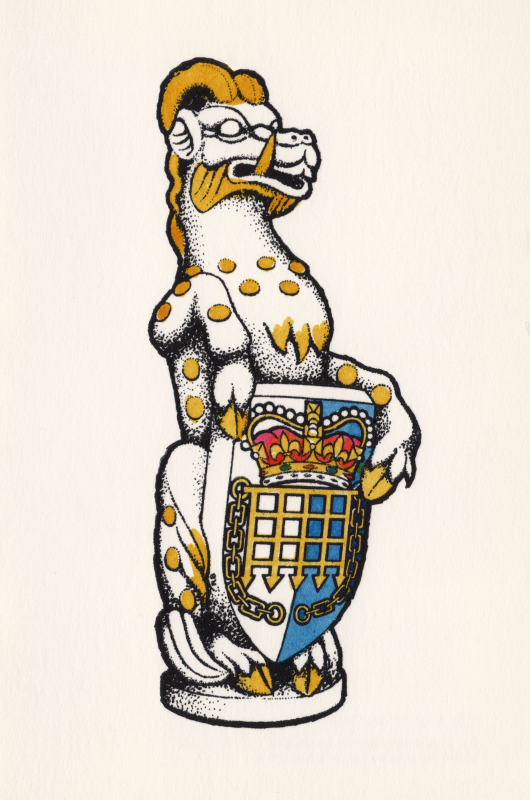
“The Yale was a mythical beast, said to be white in colour and covered with gold spots. Its peculiar characteristic was that it could swivel each of its horns independently. It descends to the Queen through Henry VII, who inherited it from his mother, Lady Margaret Beaufort. The shield shows a portcullis surmounted by the arched royal crown. The portcullis (uncrowned) was a Beaufort badge, but was used both crowned and uncrowned by Henry VII.”

Regards
Chas
IAAH Fellow

Chas
IAAH Fellow

- Chas Charles-Dunne
- Posts: 624
- Joined: 10 Jul 2012, 15:48
- Location: England - TL 80102 93862
- Contact:
Re: The Queen's Beasts
7 The White Greyhound of Richmond
“This beast was a badge of John of Gaunt, Earl of Richmond, son of Edward III, but was also used by Henry IV and especially by Henry VII. The Tudor double rose can be seen on the shield, one rose within another, surmounted by a crown, symbolising the union of the Houses of York and Lancaster.”
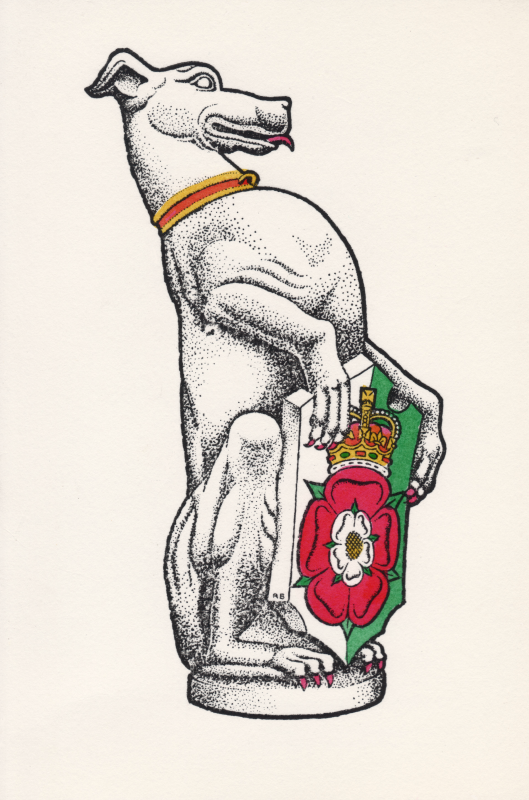
“This beast was a badge of John of Gaunt, Earl of Richmond, son of Edward III, but was also used by Henry IV and especially by Henry VII. The Tudor double rose can be seen on the shield, one rose within another, surmounted by a crown, symbolising the union of the Houses of York and Lancaster.”

Regards
Chas
IAAH Fellow

Chas
IAAH Fellow

- Chas Charles-Dunne
- Posts: 624
- Joined: 10 Jul 2012, 15:48
- Location: England - TL 80102 93862
- Contact:
Re: The Queen's Beasts
8 The Red Dragon of Wales
“The red dragon was used as his badge by Owen Tudor. His grandson, Henry VII, took it as a token of his supposed descent from Cadwalader, the last of the line of Maelgwn, King of Wales. The beast holds a shield bearing a leopard in each quarter; this was the coat of arms of Llewelyn ap Griffith, the last native Prince of Wales.”
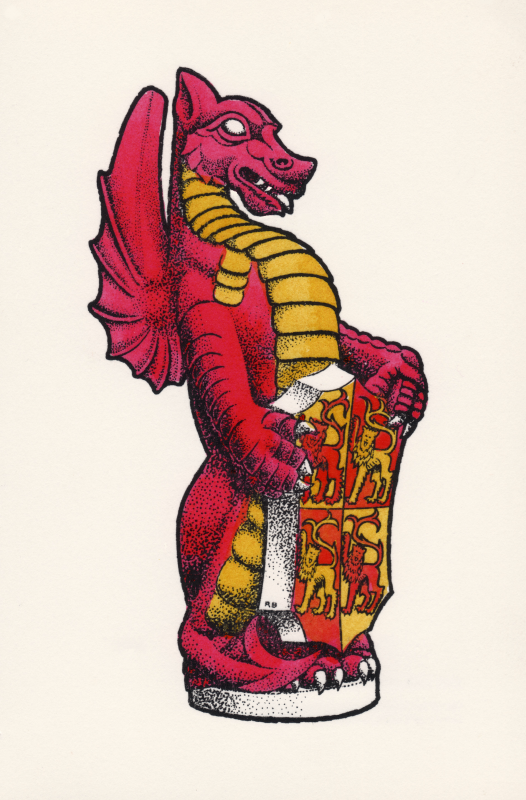
“The red dragon was used as his badge by Owen Tudor. His grandson, Henry VII, took it as a token of his supposed descent from Cadwalader, the last of the line of Maelgwn, King of Wales. The beast holds a shield bearing a leopard in each quarter; this was the coat of arms of Llewelyn ap Griffith, the last native Prince of Wales.”

Regards
Chas
IAAH Fellow

Chas
IAAH Fellow

- Chas Charles-Dunne
- Posts: 624
- Joined: 10 Jul 2012, 15:48
- Location: England - TL 80102 93862
- Contact:
Re: The Queen's Beasts
9 The Unicorn of Scotland
“From the end of the 16th century, two unicorns were adopted as the supporters of the Scottish Royal Arms. In 1603, the crown of England passed to James VI of Scotland, who then became James I of England. He took as supporters of his Royal Arms a crowned lion of England and one of his Scottish unicorns. The unicorn holds a shield showing a lion ramping in a royal tressure (a double frame), adorned with fleur-de-lis.”
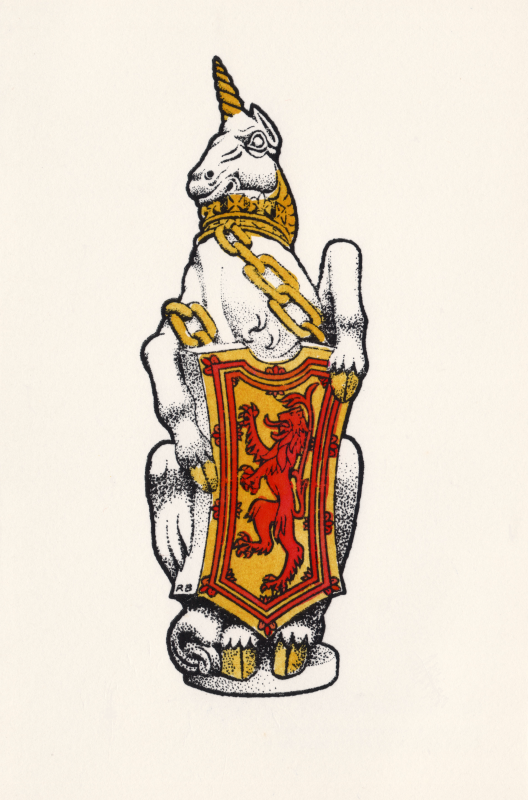
“From the end of the 16th century, two unicorns were adopted as the supporters of the Scottish Royal Arms. In 1603, the crown of England passed to James VI of Scotland, who then became James I of England. He took as supporters of his Royal Arms a crowned lion of England and one of his Scottish unicorns. The unicorn holds a shield showing a lion ramping in a royal tressure (a double frame), adorned with fleur-de-lis.”

Regards
Chas
IAAH Fellow

Chas
IAAH Fellow

Who is online
Users browsing this forum: No registered users and 11 guests